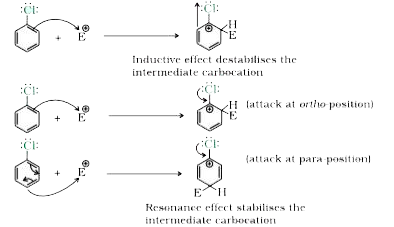Although chlorine is an electron withdrawing group , yet it is ortho-, para-directing in electrophilic aromatic substitution reactions . Why ? Solution in Telugu
Chlorine withdraws electrons through inductive effect and releases electrons through resonance. Through inductive effect, chlorine destabilises the intermediate carbocation formed during the electrophilic substitution.

Through resonance, halogen tends to stabilise the carbocation and the effect is more pronounced at ortho- and para- positions. The inductive effect is stronger than resonance and causes net electron withdrawal and thus causes net deactivation. The resonance effect tends to oppose the inductive effect for the attack at ortho- and parapositions and hence makes the deactivation less for ortho- and paraattack. Reactivity is thus controlled by the stronger inductive effect and orientation is controlled by resonance effect.
Topper's Solved these Questions
- HALOALKANES AND HALOARENESBook:NCERT TELUGUChapter:HALOALKANES AND HALOARENESExercise:Intext Question Intext Question
Explore 9 Videos
- HALOALKANES AND HALOARENESBook:NCERT TELUGUChapter:HALOALKANES AND HALOARENESExercise:Exercises
Explore 21 Videos
- GENERAL PRINCIPLES AND PROCESSES OF ISOLATION OF ELEMENTSBook:NCERT TELUGUChapter:GENERAL PRINCIPLES AND PROCESSES OF ISOLATION OF ELEMENTSExercise:Exercises
Explore 27 Videos
- ORGANIC NITROGEN COMPOUNDSBook:NCERT TELUGUChapter:ORGANIC NITROGEN COMPOUNDSExercise:Diazonium chloride
Explore 4 Videos
Similar Questions
Write the structures of the compounds
(i) 2-chloro-3-methylpentan
View SolutionGive the IUPAC names of the following compounds:
(i) CH3CH(Cl)CH(Br)CH3 (ii) CHF2CBrClF (iii) ClCH2C≡CCH2Br
(iv) (CCl3)3CCl (v) CH3C(p−ClC6H4)2CH(Br)CH3 (iv) (CH3)3CCH=ClC6H4I−p
View SolutionCopper can be extracted by hydrometallurgy but not Zinc -explain.
View SolutionHow are the following conversions effected ?
(a) C6H5NH2→C6H6
(b) C6H5NO2→C6H5OH
(c) C6H5NH2→C6H5I
(d) C6H5NH2→C6H5NO2
View SolutionHalogens are deactivating yet ortho,para directing in electrophilic aromatic substitution. Which statements do not explain this ?
View Solution(a). Why are alkyl halides insoluble in water?
(b). Why is butan-1-ol optically inactive but butane-2 ol is optically active in nature?
(c). Although chlorine is an electron withdrawing group yet it is ortho para directing in electrophilic aromatic substitution reaction. Why?
View Solution(i). Why are alkyl halides insoluble in water. ? (ii). Although chlorine is an electron withdrawing group, yet it is ortho and para directing in electrophilic aromatic substitution.
View Solutionक्लोरीन यद्यपि इलेक्ट्रॉन अपनायक समूह है फिर भी यह ऐरोमैटिक इल्कट्रोनरागी प्रतिस्थापन अभिक्रियाओं में आर्थो-तथा पैरा-निर्देशक है, क्यों?
View SolutionAmino group is ortho-, para-directing for aromatic electrophilic substitution. On nitration of aniline, good amount of m-nitroaniline is obtained. This is due to-
View SolutionWrite short notes on ortho, para directors in aromatic electrophillic substitution reactions.
View Solutionक्लोरीन यधपि इलेक्ट्रॉन आकर्षी समूह है फिर भी यह ऐरोमैटिक इलेक्ट्रॉनस्नेही प्रतिस्थापन अभिक्रियाओं में आर्थो-तथा पैरा-निर्देशक है, क्यों ?
View Solutionक्लोरोबेंजीन के इलेक्ट्रॉन स्नेही ऐरोमैटिक प्रतिस्थापन अभिक्रिया में क्लोरीन की ऑर्थो/पैरा निर्देशक क्षमता निम्नांकित में से किसके कारण होती है
View Solution(a) Why are alkyl halides insoluble in water ? (b) Why is Butan-1- ol optically inactive but Butan-2-ol is optically actove ? (c ) Although chlorine is an electron-withdrawing group, yet it is ortho-para-directing in electrophilic aromatic substitution reactions. Why?
View Solutionक्लोरीन यद्यपि इलैक्ट्रॉन अपचयक समूह है फिर भी यह एरोमैटिक इलैक्ट्रॉनरागी प्रतिस्थापन अभिक्रियाओं मे आर्थो तथा पैरा निर्देशक है, क्यों?
View SolutionThough Chlorine is an electron withdrawing group but it activate the ortho & para position in the benzene ring for electrophilic attack. Explain.
View SolutionExplain why alkoxy group (-OR) is ortho, para directing and activates the aromatic ring towards electrophilic substitution.
View Solution

